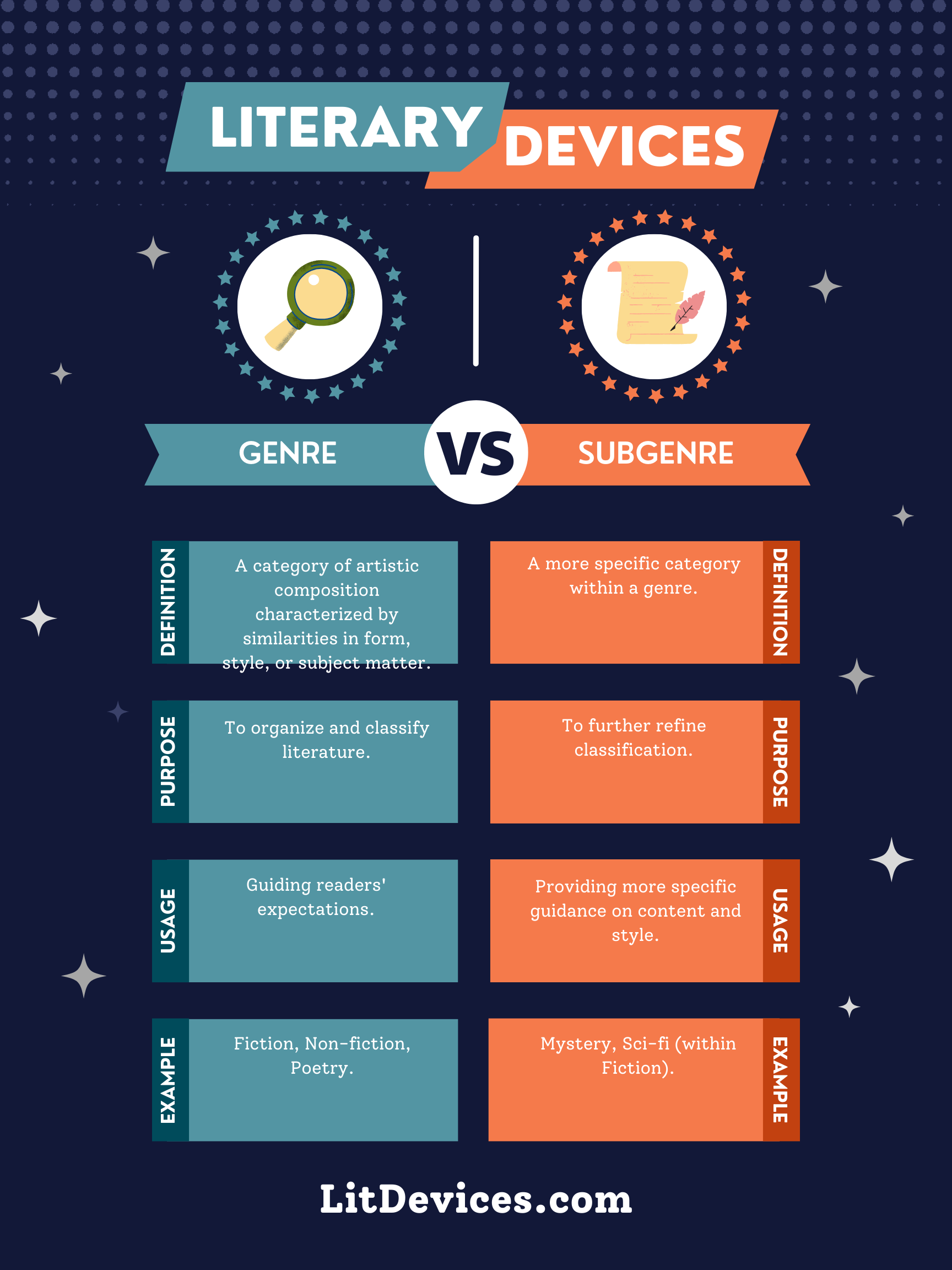Genre is a broad category of literature; Subgenre is a more specific category within a genre defined by particular elements.
Genre 📚
Genre represents overarching categories in literature that share common themes, settings, or narrative techniques. Major genres include fiction, non-fiction, poetry, and drama. Each genre guides readers’ expectations and helps authors target their intended audience. For example, the fantasy genre is known for its use of magical elements, alternative worlds, and mythical creatures.
Subgenre 🌿
Subgenres are more specific classifications within a genre, distinguished by particular themes, settings, or narrative approaches. In the fantasy genre, for instance, “high fantasy” involves stories set in an entirely fictional world with its own rules and physics, like J.R.R. Tolkien’s “The Lord of the Rings.” On the other hand, “urban fantasy” combines magical elements with real-world urban settings, such as Neil Gaiman’s “Neverwhere.”
Summary
| Literary Device | Definition | Purpose | Usage | Relevant Examples |
|---|---|---|---|---|
| Genre | Broad categories of literature with shared characteristics. | To guide reader expectations and provide a framework for storytelling. | Across all types of literature. | Fiction, Non-fiction, Poetry, Drama. |
| Subgenre | More specific categories within a genre, defined by unique elements. | To further refine and specify the type of story being told. | Within genres to target niche audiences. | High Fantasy, Urban Fantasy within the Fantasy genre. |
Writing Tips
When navigating genre or subgenre in your writing, consider these tips:
- For Genre: Understand the conventions of the genre you’re writing in. This doesn’t mean you can’t innovate, but knowing what readers typically expect can help you satisfy or thoughtfully subvert those expectations.
- For Subgenre: Dive deep into the specific elements that define your chosen subgenre. Emphasize these in your storytelling to stand out to readers who are fans of that niche.
FAQs
Q: Can a book belong to more than one genre or subgenre?
A: Yes, many books straddle multiple genres or subgenres, blending elements to create rich, multidimensional stories.
Q: How do I choose the right genre or subgenre for my story?
A: Consider the core elements of your story—the setting, characters, plot, and themes—and match them to the genre or subgenre that best aligns with these aspects.
Q: Does every genre have subgenres?
A: Most genres have subgenres, as they allow for more specific grouping of stories with similar characteristics within the broad spectrum of the primary genre.
Exercise
Consider the description below and decide if it refers to a genre or a subgenre:
“A story set in a technologically advanced future, focusing on space exploration, advanced science, and technology.”
Answers:
- This description refers to a Subgenre, specifically “Science Fiction,” and even more specifically, it could be categorized under “Space Opera” or “Hard Science Fiction” depending on the emphasis on scientific accuracy or dramatic narrative.
Other Device Comparisons You May Find Interesting
- Plot vs Theme: Exploring the difference between the story’s events and its underlying message.
- Characterization vs Development: Distinguishing between how characters are portrayed and how they change over time.
- Narrative Voice vs Point of View: Comparing the overall storytelling style with the perspective from which the story is told.
- Tone vs Mood: Differentiating between the author’s attitude toward the subject and the atmosphere of the story.
Unpacking the layers of Genre and Subgenre opens a world of storytelling possibilities, helping writers craft stories that resonate with specific audiences while exploring the vast landscapes of literature.

